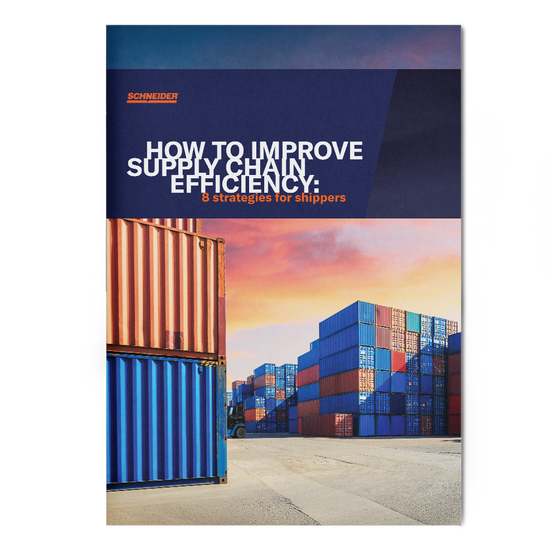Shipper | Market updates 3 min. read
How to mitigate supply chain risk in volatile freight markets

The freight industry has been operating in a shippers’ market with abundant capacity, low rates and high service expectations. While shippers enjoy the ease of securing capacity on demand and strong negotiating power, that era is drawing to a close. Market conditions are shifting, and the signs of volatility are becoming impossible to ignore.
How prepared are you when the market changes? In a volatile freight environment, agility is the key to long-term success. This article highlights the biggest risks to supply chains and shares practical strategies to help reduce those risks.
The supply chain risk landscape
Understanding the forces behind market instability is the first step toward resilient supply chain planning. Here are five key factors currently reshaping the freight landscape:
Rising insurance costs
Commercial trucking insurance premiums have risen sharply in recent years due to:
- Nuclear verdicts.
- More frequent lawsuits.
- Rising repair costs.
Smaller carriers, already operating on thin margins, are particularly vulnerable. As these carriers leave the market, available capacity shrinks and rates climb.
Carriers leaving the market
The freight market saw a wave of carrier closures in 2024 and 2025. Many small and mid-sized fleets were unable to weather rising costs and declining spot rates. This trend is expected to continue as economic uncertainty persists.
English Language Proficiency enforcement
Recent regulatory enforcement around English Language Proficiency (ELP) requirements is having a significant impact on B1 visa holders and immigrant drivers. Those involved in cross-border freight are most affected. Stricter ELP enforcement is leading to disqualifications, delays and a shrinking labor pool.
Trade policy tariff uncertainty
Trade tensions and shifting tariff policies, especially between the U.S., China and Mexico, are making it harder to predict costs and plan sourcing strategies. A sudden tariff hike can disrupt budgets and supply chains overnight.
Fuel cost volatility
Fuel prices remain one of the most unpredictable cost drivers in freight. Factors leading to price swings and reduced margins include:
- Geopolitical instability.
- Refinery outages.
- Low strategic reserves.
These risks are not isolated—they’re connected and intensifying. The result is a freight market that’s increasingly difficult to navigate. Withstanding a market change requires a proactive risk management strategy.
4 supply chain risk mitigation strategies
Optimize operations and efficiency
Optimize load efficiency by collaborating with providers who focus on improving route planning. Engage in scenario planning by developing contingency strategies for sudden capacity losses. Tactics include securing backup carriers and exploring alternate transportation modes.
To further enhance efficiency, leverage digital freight platforms. These provide real-time visibility and quickly address gaps when traditional carriers are unavailable.
Enhance carrier partnerships
Focus on building strategic relationships with stable providers who can withstand market fluctuations. Invest in thorough carrier vetting to ensure carriers meet ELP standards and maintain a qualified driver workforce. Support carriers that prioritize workforce development with language training and certification programs.
Additionally, using a variety of carriers lowers your risk by avoiding reliance on just a few. Negotiate long-term contracts with trusted partners and lock in rates and capacity. This protects operations from short-term market spikes.
Embrace sustainability and innovation
Embracing sustainable practices is key. Implement transparent fuel surcharge programs to maintain fairness and adaptability in pricing. Partner with carriers that invest in electric or alternative fuel fleets to mitigate diesel volatility. Explore modal shifts, such as intermodal, to reduce long-haul trucking reliance and minimize labor disruptions.
Strengthen regional and regulatory strategies
To build greater resilience, consider nearshoring and regional sourcing. By sourcing closer to home, supply chains have less dependence on global trade and its volatility. Pair these strategies with expert customs advisory services to stay ahead of regulatory changes and ensure compliance.
From risk to resilience
Market change is unavoidable. The most resilient shippers are those who act now to identify risks and implement mitigation strategies. Successful tactics include diversifying carriers, investing in strategic partnerships and planning for regulatory and economic shifts.
Now is the time to evaluate your current strategy. Because when the market turns, those who plan ahead will be the ones who thrive.

Start building resilience today
Discover how to optimize your current supply chain strategy in our free guide.
Related resources
Drive your business forward
Sign up to receive our industry leading newsletter with case studies and insights you can put to use for your business.












